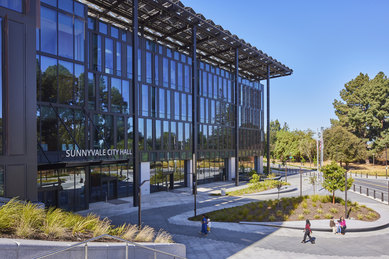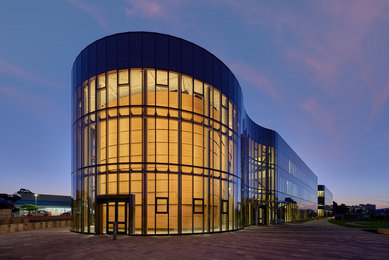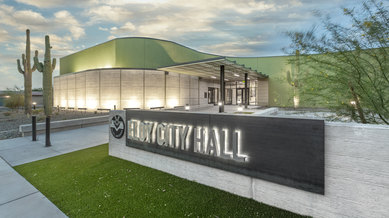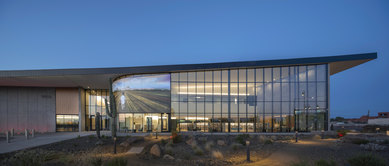The Contemporary Civic Center – Practicality and Purpose
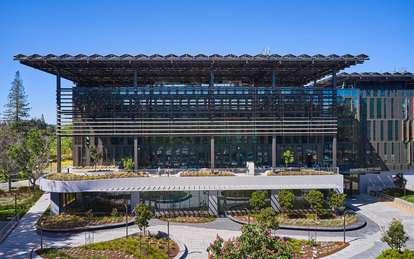
Fundamentally, the purpose of civic centers has remained relatively unchanged throughout history, steadfastly serving as the soul of a community. From a practical standpoint, civic centers are intended to serve society and reflect the setting and period within which they are shaped. As such, civic values that guided an era are expressed in the architecture and spaces created during that time. For instance, one can understand the fundamentals of early Greek society by studying its agora, which included buildings and gathering places for debate, socializing, education, worship, adjudication, and finance. Contrast that with the city halls and civic plazas of the Federalist-aged 1800s, which reflected society’s move toward regularity and structure, or even the early 1900s Beaux Arts period city halls, which were meant to inspire and awe. Today, we ask ourselves, “How should a contemporary civic center define itself and what should it convey regarding current values for centuries to come?”
Regardless of location or the age in which it was built, each civic center has a purpose—which is aspirational—and a function—which is fundamental. Purpose is rooted in and unique to a given community; it is uncovered through engagement and derived through town hall meetings, design charettes, surveys, the sharing of oral histories, visualization exercises and more. In terms of function, these facilities are often intended to meet a somewhat similar range of local business and community needs.
Exploring four recent civic center projects designed by SmithGroup, one can see how the unique aspirational and functional visions of each community gave rise to a range of contemporary design solutions reflective of the diverse communities in which these facilities are found.
Located in California’s Silicon Valley, the aspirational and functional drivers for the City of Sunnyvale’s new Civic Center and Campus were defined through a series of robust community engagement efforts, beginning with an extensive and comprehensive master planning process comprised of focus groups, public commission meetings and communitywide workshops. Nestled in a parklike setting in the heart of the city, this project reflects a progressive community unafraid to embrace new technologies in support of sustainability and resilience. The concepts that guided its design were founded on aspirations including respect for site and history, transparency and a commitment to future generations. Site and buildings are inextricably linked and reflect the vision, culture and vibrancy that make Sunnyvale so unique.
The South San Francisco Civic Complex, though geographically proximate and functionally similar to Sunnyvale, was purposefully designed to achieve different goals and objectives. This complex actively engages the varied demographics and age groups that comprise the community, incorporating pre-kindergarten playgrounds, adult active zones and quiet garden areas filled with wildflowers and native grasses for reflection and contemplation. These grounds slip into a sliver of a site that wraps around a glass curtainwall, creating strong connections to the surrounding geography, highlighting views of Sign Hill and the San Bruno mountains. Similar to facilities at nearby Sunnyvale City Hall, contemporary functional spaces include a council chamber and administrative offices and encompasses a library. Parks and a range of recreation spaces were also incorporated to accommodate community meetings, public access to computers and technology, maker spaces, art classrooms and multi-function rooms for gatherings and events.
The Eloy City Hall, located in Arizona, may seem a world away from the San Francisco Bay Area, and in many ways it is. The desert has always presented architects with unique challenges and opportunities. The purpose of this facility was to be a “living room” for Eloy’s diverse communities—especially seniors – and at the same time to serve as the seat of city government. At first blush, one notices the gentle undulation of the city hall rendered in a green stucco similar in color to the iconic surrounding Arizona cacti. The interior is airy, spacious and egalitarian. Glass walls allow the public to see administrative functions along the north end of the spine, including the mayor’s office, planning agency and city council chambers. The south side of the spine houses services used by residents and a multi-function space for events such as weddings, with garage-style doors that open to the south side of the property and the adjacent park. Additional square footage is set aside for business incubator or pop-up retail space, further encouraging downtown activity.
Tolleson Civic Center, located in a suburb of Phoenix, Arizona, is a tight-knit, family-oriented and largely Hispanic community, incredibly proud of its historical and cultural heritage. With meatpacking as its largest industry, this civic center finds inspiration within economic constraints. The purpose is much larger than the building. Discovered through town hall meetings and charettes engaging the city’s diverse population, the Tolleson Civic Center will intentionally act as the community’s front door and living room. Local artwork will be highlighted as a welcome for the community into their new home and a large courtyard will support community events including the beloved annual Luces de Navidad Street Festival. Functionally, it will serve as an administrative center, housing the city’s main library and senior community center. Designed to optimize natural light without heat gain, the building’s orientation and sloping roof provide practical solutions with positive aesthetic impacts. Surrounded by mountains, the building seems to spring from the earth and makes best use of the passive resources.
Perhaps through this exploration a simple answer to the question posed earlier emerges: How should a contemporary civic center define itself and what should it say about today’s values for the centuries to come? Likely, it should be an expression as diverse as the community it is rooted within and responsibly designed to manage the planet’s limited resources.
